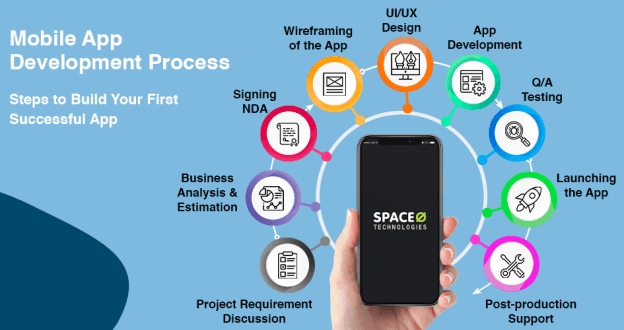What are the five steps of mobile app development?
In this era, mobile is important for human being same as they need bread and clothes, they may forget to take meals sometimes but can’t forget to bring their mobile phones.
Are you interested in getting familiar with the mobile development process from soup to nuts? If YES, you will be glad to hear that in this blog post, we will elaborate on the same.
Mobile app development is a complex process that involves several steps from conceptualization to deployment. Developing a mobile app requires a comprehensive plan and a structured approach. We will discuss the five essential steps of mobile app development in this read, so follow it further.
Here are the 5 steps of mobile app development
- Conceptualization and Planning: The first step in mobile app development is conceptualization and planning. This step involves brainstorming and developing a clear idea of the app's purpose and functionality. This stage includes defining the target audience, understanding their needs and requirements, and identifying the app's unique selling point.Once you have a clear idea of what you want to achieve with your mobile app, it's time to start planning the app's design and features. A well-planned app will help you create a clear roadmap for the entire development process.
- Designing and Prototyping: Once you have a clear idea of the app's purpose and features, it's time to move on to designing and prototyping. This step includes creating wireframes, mockups, and prototypes of the app's interface and user experience.During this step, it's essential to focus on the app's usability and ensure that the user interface is intuitive and easy to navigate. The design of the app should also be visually appealing and in line with your brand's image.
- Development: After designing and prototyping, it's time to move on to development. This step involves writing code, integrating features, and developing the app's backend. The development process can be time-consuming and requires a skilled team of developers. During development, it's essential to maintain a focus on the app's functionality and ensure that it is bug-free. Testing and debugging the app at each stage of development can help catch issues before they become major problems.
- Testing: Once the app is developed, it's time to move on to testing. This step involves testing the app's functionality, performance, and user experience. It's crucial to ensure that the app works seamlessly on different devices, operating systems, and screen sizes.During testing, it's essential to focus on the app's security and ensure that it is free of vulnerabilities. A thorough testing process can help identify and fix any issues before the app is deployed to users.
- Deployment and Maintenance: The final step in mobile app development is deployment and maintenance. This step involves deploying the app to app stores and making it available to users. Once the app is deployed, it's important to monitor its performance and maintain it by releasing updates and fixing bugs.
In addition to regular maintenance, it's crucial to gather feedback from users and continuously improve the app. A well-maintained app can lead to higher user engagement and retention.
Final words!
In all, developing a mobile app is a complex process that requires a structured approach. The five essential steps of mobile app development are conceptualization and planning, designing and prototyping, development, testing, and deployment and maintenance. By following these steps, you can ensure that your app is functional, user-friendly, and provides a great user experience.

Comments
Post a Comment